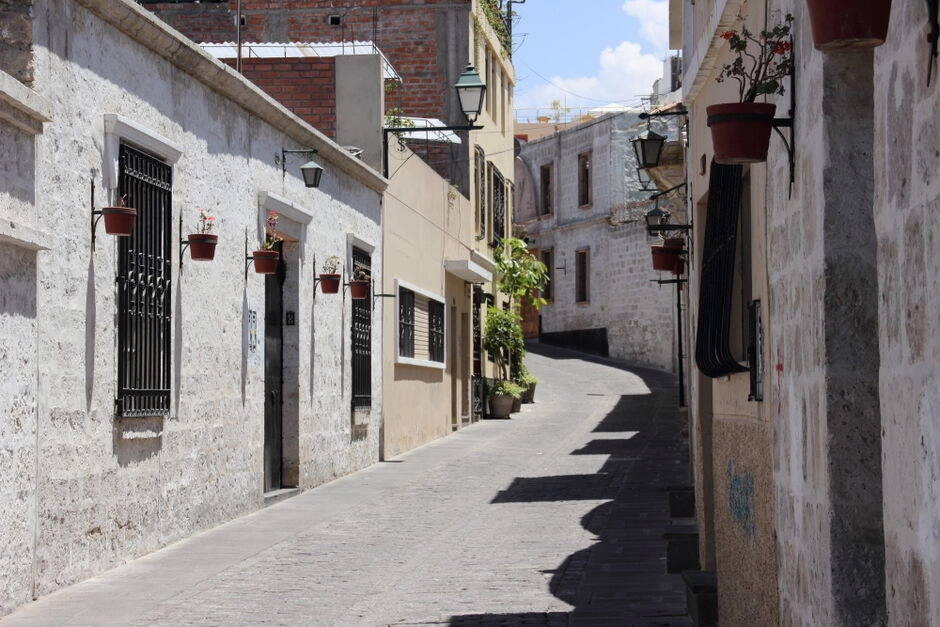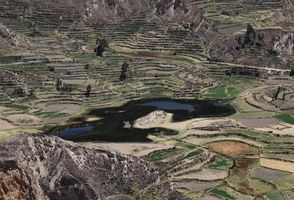
Ready to experience the wonders of Peru? Get in touch, and we’ll help you plan the adventure of a lifetime!

Ready to experience the wonders of Peru? Get in touch, and we’ll help you plan the adventure of a lifetime!

Email Consent Notice
By checking the box, you consent to PeruVisit.com collecting and processing your email address for the purpose of sending newsletters, promotional offers, and information about tours in Peru.
You acknowledge and understand that:
For full details on how we manage personal data, please refer to our Privacy Policy.
The City's Name
The Museum of Andean Sanctuaries
Santa Catalina Monastery
El Misti Volcano
Huaynaputina Volcano
The Enigmatic Valley of Volcanoes
The Petroglyphs of Toro Muerto
Colca Canyon
Cotahuasi Canyon
When to Visit
How to Get to Arequipa
The stunning city of Arequipa is nestled in a fertile valley at an altitude of 7667 feet (2335 meters) above sea level, surrounded by the majestic Misti, Chachani, and Pichu-Pichu volcanoes. With its predominant use of white volcanic rock known as sillar in construction, Arequipa sparkles like a gem in the sunlight, earning it the nickname "white city" or "la ciudad blanca."
But Arequipa is not just a pretty face. Its architecture stands as an exquisite example of colonial design, boasting a unique blend of Spanish and indigenous influences. It's no wonder that in the year 2000, Arequipa was rightfully inscribed into UNESCO's World Heritage list.
As the second-largest city in Peru, Arequipa also serves as a significant economic hub. So whether you're a history buff, an architecture enthusiast, or a business traveler, Arequipa has something for everyone. Get ready to experience the magic of this majestic city!

Nestled along the earth's fiery fault line, Arequipa is a city that brims with excitement. Its location along the "cadena del fuego" or "Ring of Fire" makes it a hotbed for powerful earthquakes that shook the region in 1958, 1960, and 2001. This is a city that has seen the earth shake and rise from the ashes time and time again, and it continues to thrive despite the challenges it faces. Founded on August 15, 1540, by the adventurous Spanish conquistador Pedro Anzúrez de Camporredondo, Arequipa has a rich history that dates back to the dawn of civilization. Archaeological studies reveal that the valley where the city now stands was inhabited as far back as the 6th and 7th centuries BCE. The Aymara indigenous peoples inhabited this territory before the Incas conquered it in the 15th century.
Legend has it that the fourth Inca, Mayta Capac, once came to a halt here. As one of the soldiers asked for permission to stay, the Supreme Inca responded in Quechua with a resounding "Ari, quepay" which means "Yes, stay". Another version of the story suggests that the city's name is linked to an ancient Aymara dialect expression, "Ari qquepan", which translates to "the sound of a trumpet or horn", a signal for the beginning of war. Whichever the true origin may be, the city's name holds an exciting tale of ancient times, making it all the more fascinating to visit and learn about.

Attractions in Arequipa and Surroundings
Arequipa boasts a wealth of captivating museums. Here are just a few:
The Museum of Andean Sanctuaries (Museo de Santuarios Andinos)
The highlight of this museum is the mummy Juanita, also known as the "Ice Maiden". Juanita was discovered in 1995 on Mount Ampato near the volcano's crater, and her remarkably preserved body is one of the best-preserved mummies in the world.
She was wrapped in alpaca wool fabric and buried with wooden and golden figurines and other items. According to carbon dating, Juanita died between 1440 and 1450, at the age of 11-15, and is believed to have been sacrificed by Inca priests.
Museum Address: La Merced, 110, Arequipa.
Santa Catalina Monastery (Monasterio de Santa Catalina)
This stunning complex dates back to 1580 and covers an area of 7.7 square miles (20 square kilometers). Once home to 450 residents, the Santa Catalina Monastery is now inhabited by only 20 nuns, who continue to preserve the legacy of this beautiful place.
The monastery's architecture and decoration are breathtaking, with vibrant colors, blooming flowers, and orange trees contrasting with the blue skies of Arequipa. Explore the galleries, chapels, and cloisters of this enchanting monastery, and let yourself be transported to a different time and place!

Imagine exploring a secluded area that was once a miniature city, containing its streets, alleys, and squares! That's exactly what you can do when you visit the Santa Catalina Monastery in Arequipa. With over 100 rooms, 3 covered galleries, a church, and an art gallery called Pinacoteca, this place is a true architectural marvel. The covered galleries showcase magnificent frescoes, while the Pinacoteca exhibits paintings by masters of the Cusco school. During restoration in 1970, a hidden treasure trove of over 400 religious paintings from the 16th century was discovered in the Pinacoteca. Many of these paintings are now considered prime examples of religious art on the continent.
Monastery Address: Calle Santa Catalina, 301, Arequipa
Surroundings of Arequipa
The majestic Misti Volcano, soaring to an impressive 19,101 feet (5,822 meters) in height, looms just 10.6 miles (17 kilometers) from the enchanting city of Arequipa. This dynamic volcano has experienced five minor eruptions in the last century, the latest of which occurred in 1985. Remarkably, in 1998, explorers unearthed six Inca mummies near the volcano's inner crater, now carefully preserved at the captivating Museum of Andean Treasures (Museo de Santuarios Andinos) in Arequipa.
Excitingly, an extraordinary opportunity awaits - embark on an expedition to conquer Misti! Typically spanning two days, this ascent promises an exhilarating adventure for those craving a thrilling experience amid the breathtaking landscapes of this volcanic wonder.
Huaynaputina Volcano (Huaynaputina, Wayna Putina)
Approximately 45-50 miles (70-80 kilometers) from Arequipa lies another volcanic wonder – the Huaynaputina volcano renowned for its catastrophic eruption on February 19, 1600. The echoes of this volcanic upheaval resonated across continents, weaving a tale of interconnectedness that shaped destinies far beyond the landscapes of Latin America.
The Enigmatic Valley of Volcanoes (Valle de los Volcanes)
Embark on a mesmerizing journey to the Valley of Volcanoes, nestled alongside the Andagua River, a spellbinding 234 miles (377 kilometers) north of Arequipa. Here, a surreal realm unfolds—where the earth, adorned in hardened lava, cradles peaks that soar over 80 dormant volcanoes, crafting a landscape that mirrors the unearthly, lunar landscape.

The Petroglyphs of Toro Muerto (Toro Muerto)
Embark on a 2.5-hour bus journey west of Arequipa, and you'll find yourself amidst a captivating area of over 1.93 square miles (5 square kilometers), adorned with over 3000 stones bearing petroglyphs — ancient rock art — from the pre-Inca Wari civilization (19th-12th centuries BC). These intricate drawings depict plants, animals, and anthropomorphic representations of gods — all that held significance in the vibrant culture of the Wari people.
Toro Muerto unveils a window into the artistic and spiritual expressions of a bygone era. You will get to connect with the rich tapestry of Wari heritage and marvel at the intricate details of their artwork. Don't miss out on this incredible opportunity to experience the cultural wonders of a bygone era!






Situated approximately 110 miles (180 kilometers) from Arequipa, Colca Canyon stands as one of the world's deepest canyons, plummeting to a depth of 11,154 feet (3,400 meters). This natural marvel provides an ideal playground for enthusiasts of rafting, hiking, or mountain biking. Moreover, it offers a spectacular opportunity to witness the majestic flight of the condor!
Excursions to Colca Canyon from Arequipa open up avenues for exploration.

A bit further, approximately 248 miles (400 kilometers) northwest of Arequipa, lies another awe-inspiring canyon - Cotahuasi. Boasting a depth of 11,598 feet (3,535 meters), it proudly holds the title of the world's deepest canyon. A significant portion of Cotahuasi Canyon is designated as a reserve, featuring attractions like the 'Stone Forest' of Santo Santo spanning 1,930 square miles (5,000 square kilometers), pre-Inca agricultural terraces, the towering 'Forest of Giant Cacti' reaching heights of 39-43 feet (12-13 meters), and the majestic Pujuyo Raymonda.

The region around Arequipa enjoys a dry and pleasantly warm climate throughout the year, with daytime temperatures ranging from 68-77°F (20-25°C) and nighttime temperatures averaging 41-50°F (5-10°C). Therefore, it's a wonderful destination to explore at any time.
By Plane
Arequipa is located 629 miles (1,010 km) from Lima and 324 miles (521 km) from Cusco. A flight from Cusco or Lima takes approximately one hour.
By Bus
If you prefer the scenic route, a bus journey will take around 16 hours from Lima and 12 hours from Cusco.
Reach out to us and let's plan the perfect tour that suits both your budget and your vision of an unforgettable adventure!


Get in touch, and we’ll help you plan the adventure of a lifetime!